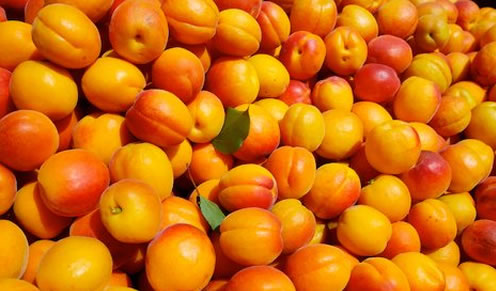Fruit looks scrumptious as well as being packed with vitamins and nutrients that the body needs, right? Wrong. Although fruit is a necessary part of our diet, and of the food pyramid, some people have accidentally died as a direct result of eating the wrong fruit or too much fruit. Before you next munch on a healthy snack, keep in mind this list of poisonous yet tempting fruits.
1) Apricots
 |
The velvet-skinned apricot is a relative of the peach. They are a terrific source of beta-carotene which converts to Vitamin A in the body. It can help keep the eyes, skin, hair and gums healthy, as well as help the body fight infection. They can be eaten dried, canned or fresh. A fresh apricot can provide the daily recommended dose of vitamin A. In all the 50 known varieties of apricots, however, the pit contains amygdalin. This is poisonous when consumed in large doses. A person would have to split open the pit to expose the dangerous and deadly chemical to the body. In fact, apricot pits are sold in some health food stores as a natural supplement. Don’t eat more than one or two pits a day. At the least, stomach discomfort or nausea can occur. Sometimes too much amygdalin can be fatal.
2) Plums
 |
Plums look simply scrumptious. They are relatively low in fat while being nutritionally high in vitamins C and A. Plums can be eaten raw, used to make jam or to make plum wine. Take heed of this warning, though, as danger lurks in sweet and juicy plums. Plum seeds contain cyanogenetic glycocides, a substance that can change into a killer in the body. The body can detoxify small quantities of cyanide, so lots of plum pits would need to be consumed to die from the poison. We don’t tend to let small children put seeds in their mouth. But the chance of poisoning is a far more ominous reason than choking to keep the seeds away from wee ones.
3) Pears
 |
Pears have a bell-shaped body and can range in color from green, yellow, brown, red or a combination of these colors. They are a carbohydrate and can provide potassium, vitamins and a quick dose of energy. The inner fruit in a pear is more “gritty” than an apple. There are more than 30 species of pears. People eat them poached, canned or raw. The pip, or seed, of a pear is potentially dangerous to humans and pets. Pear seeds are listed as toxic and fall under the category to call the poison control center if ingested. As long as you don’t eat a cup full of pear seeds, crunching the outside protective coating off the seed, then eating pears is not extremely lethal. A quince is also in the pear-like fruit category, but don’t eat a quince that hasn’t been cooked. Sickness or even death can occur.
4) Cherries
 |
Sweet ripened cherries are yummy. Cherries are in large demand for being eaten raw, for cooking, for flavoring foods and drinks, as well as for liqueur production. These plump and fleshy fruits contain one seed per cherry. Although the red pigment in cherries contain healthy and potent antioxidants, the cherry seeds, stems, and leaves have poisonous properties. If the sugary pit is split open, it can release a toxin in the cyanide family. Cyanide is one of the poisons that Nazis used in the gas chamber to kill prisoners in World War II death camps. The cherry seed, pip, can prove deadly when even slightly cracked open, so remember not to chomp or suck on the pit next time you eat a cherry.
5) Peaches
 |
Soft and fuzzy on the outside, peaches are pretty as a picture and even more tasty. The scent of a fresh ripe peach is almost too tempting to pass up, while the slightly acidic tang mixing with the sweet juicy fruit make peaches extremely popular. Peaches are low in saturated fat, sodium and cholesterol, while still managing to be packed full of vitamins and necessary dietary fiber. In a bizarre twist, however, the peach that is so good for the body also houses a pit that contains poisonous chemicals. Thankfully, large peach pits are nearly as hard as a rock and would prove difficult to crack with your teeth. You are safe to eat peaches as long as you don’t pulverize and consume the poisonous pits.
6) Apples
 |
Everyone has heard the saying, “An apple a day keeps the doctor away,” and the fiber and vitamins in apples have been proven to help reduce the chances of atherosclerosis and heart disease. Eating apples raw, as applesauce, pie or even just juice is a common way to combat illness. They come in many colors and varieties. Apples have tempted many throughout the ages, from Eve to Snow White, but apple seeds contain cyanide. Fortunately apple seeds have a tough protective coating that keeps the seed “shell” safe when eaten except if the seeds are crushed or cracked open. Eating one entire apple, seeds and all, would not be enough to make you sick. Eating huge amounts of apple seeds, especially if the seeds are pulverized, could prove fatal. For small children, it would take considerably less as too many apple seeds can be lethal.
